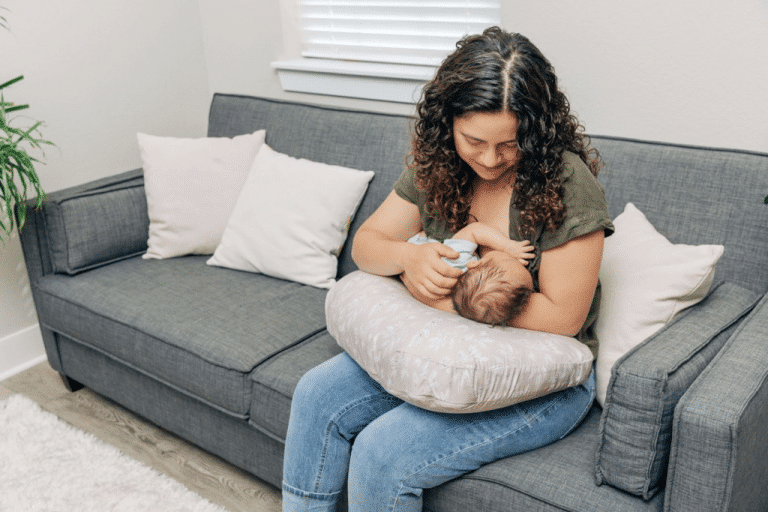Parents with new babies often ask me about sleep. It’s hard when your baby wakes up often at night.
Many moms and dads try the “Eat, Play, Sleep” method to help their little ones rest better.
This method follows a simple pattern. First, feed your baby.
Then, give them time to play and be active. Finally, put them down for sleep.
Following this pattern can help babies learn good sleep habits.
It makes the day more organized for parents, too.
Plus, it helps babies understand when it’s time to rest.
Let me explain how you can make this work for your family.
What is the “Eat, Play, Sleep” Routine?
This method gives your day a clear pattern. Your baby first gets a full meal.
After eating, it’s time for active moments like tummy time, looking at toys, or being held.
When your baby shows signs of being tired, it’s time for rest.
The key point is keeping food and sleep apart.
When babies eat right before sleep, they might need feeding to fall asleep later.
By adding play between meals and rest, babies learn to sleep on their own.
This helps both during naps and at night.
Benefits of the “Eat, Play, Sleep” Routine
Helps Babies Learn to Self-Soothe
When babies can fall asleep without eating, they develop better sleep skills.
Playtime after meals keeps them alert and active. This means they’re not depending on food to rest.
Your baby starts noticing that sleep comes after play, not food.
They learn to calm down naturally. Over time, this means less waking up at night for feeds.
Parents can help by giving gentle back rubs or soft sounds instead of feeding when it’s sleep time.
Promotes a Predictable and Flexible Schedule
This method creates a daily flow that works for everyone. You can plan your day while still meeting your baby’s needs.
Some days, feeds or naps might come earlier or later – that’s okay. The routine helps babies tell day from night.
Morning feeds followed by play send a clear message: it’s time to be awake.
As night comes, the routine signals sleep time is near.
Encourages Full Feedings
Regular meal times help your baby eat better. Instead of small snacks throughout the day, they take full feeds.
This means they stay full longer and sleep better. When babies aren’t sleepy during meals, they eat more actively.
This stops the cycle of short feeds and frequent wake-ups.
Better feeding during the day means better sleep at night for everyone.
When to Start the “Eat, Play, Sleep” Routine
Starting Around One Month Old
Wait until your baby is one month old before starting this routine.
During the first few weeks, babies need time to settle into life outside of their mom. They mostly eat and sleep as needed.
Your newborn first needs basic comfort with swaddling, gentle sounds, rocking, side position, and sucking. These help them feel safe.
Once your baby starts having longer wake times, you can begin adding small play sessions after feeds.
Watch for Baby’s Developmental Readiness
Look for signs your baby is ready.
They might stay awake longer after feeds, look around more, and show interest in their surroundings.
Their sleep patterns might become more regular, too.
Pay attention to how your baby responds. Some babies take to the routine quickly.
Others need more time. Change things based on what works for your baby.
Trust your instincts about when your little one is ready.
How to Implement the “Eat, Play, Sleep” Routine
Step 1: Feeding
Feed your baby in a quiet place without loud noises.
Make sure they stay awake during feeds by tickling their feet or talking softly.
This helps them eat enough at each meal. Keep track of when your baby eats.
Try to feed every 1.5 to 2 hours during the day. This helps build a pattern.
Watch for signs your baby is full, like turning away or slowing down.
Step 2: Playtime
After feeding, try simple activities. Put your baby on their tummy for short periods.
Show them black and white pictures. Talk or sing to them. Hold them up to look around the room.
These activities help your baby grow stronger and learn new things.
Playing during the day also teaches them when to be active.
Keep playing gently and watch for signs your baby is getting tired.
Step 3: Nap/Sleep
Put your baby down when you see tired signs.
Look for yawning, rubbing eyes, or becoming fussy.
Please don’t wait too long, or they might get too tired to sleep well.
Use white noise and dim lights before sleep time. Keep the room quiet and dark.
Some babies need 5-10 minutes of fussing before falling asleep.
That’s normal and helps them learn to rest on their own.
Common Misconceptions About the “Eat, Play, Sleep” Routine
Babies Should not be Played With Immediately After Eating
Some think babies need complete rest after eating. But small, calm activities are fine.
Just keep them gentle. Pat your baby’s back, talk softly, or look at pictures together.
This quiet play helps food settle and keeps your baby from linking eating with sleeping.
It doesn’t need to be active play.
Even looking around the room counts as play for young babies.
“Eat, Play, Sleep” is not a Strict Schedule
This routine is a guide, not a rule book. Some days, your baby might need more food or sleep.
That’s okay. Follow what your baby needs each day. Think of it as a pattern, not a fixed schedule.
If your baby seems hungry before the usual feeding time, feed them.
If they’re tired after a short play, let them sleep.
The routine should work for you, not the other way around.
Challenges of the “Eat, Play, Sleep” Routine
1. Resistance to Naps or Playtime
Some babies fuss during play or fight naps. If your baby gets upset during play, try smaller activities.
Hold them near a window or show them simple toys.
Keep play sessions short at first. For naptime troubles, watch for signs of early tiredness.
Put them down when they first yawn or rub their eyes.
Use a dim room and soft sounds. If they cry, pick them up and try again in 10 minutes. Small steps make big changes.
2. Adjusting the Routine for Different Ages
Your baby’s needs change as they grow. Young babies need shorter wake times, maybe 45 minutes.
Older babies stay awake longer, up to 2 hours. Change play based on age, too.
Young babies enjoy looking at faces and simple sounds.
Older babies like toys and movement more. Match activities to what your baby can do.
Let them guide you on how long to play.
Alternatives and Modifications to the “Eat, Play, Sleep” Routine
The “Eat, Sleep, Play” Option
Some babies sleep better right after eating. That’s fine – you can change the order.
Feed your baby, let them sleep if they’re tired, then play when they wake up.
This works well for many families. The key is finding what helps your baby sleep best.
The order can be flexible as long as your baby sleeps well and eats enough.
Incorporating the 5 S’s With “Eat, Play, Sleep”
Use swaddling and white noise at sleep times. Rock or hold your baby gently during calm play.
These methods help babies feel safe and calm. These tools work well with any routine.
They give babies extra comfort when needed.
Use them when your baby seems upset or tired. They help make changes easier.
Tips for Success With the “Eat, Play, Sleep” Routine
Consistency is Key
Try to keep similar patterns each day. This helps your baby learn what comes next.
Even if times change, keep the order the same when possible.
Your baby will start knowing what to expect. This makes naps and bedtime easier.
Give the routine time to work. It takes a few weeks for babies to learn new patterns.
Stay Calm and Flexible
Some days won’t go as planned. Your baby might need extra feeds or skip playtime.
That’s normal and okay. Take a deep breath and adjust your plans. Remember, every baby is different.
What works today might need changes tomorrow. Trust yourself to know what your baby needs.
Small changes each day add up to better sleep over time.
Conclusion
The “Eat, Play, Sleep” method can make life easier for you and your baby.
I know as a parent, you want what’s best for your little one.
This routine helps create better sleep habits and makes your days more organized.
Start with small changes. Try the routine when it feels right for your baby.
Some days will be perfect, others won’t, and that’s okay.
Every baby is different. What works for one might not work for another.
Listen to your baby’s needs and adjust as needed.
With time and patience, you’ll find the right balance that works for your family.










